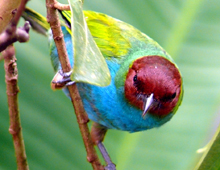Description: Bay-headed tanagers have a bright reddish, chestnut colored head with a narrow yellow collar on the hind neck; a bright grassy- green back; the rump and underparts are turquoise blue; and the flanks and under tail-coverts are green. Males and females are alike in appearance, except females are duller and paler in color.
Size: Bay-headed tanagers are small birds, reaching only 5.5 inches (14 cm) in length.
Behavior: They are very social birds, living in pairs or small groups and/or mixed flocks with other species of tanagers and honeycreepers.
Diet: Their diet consists primarily of fruit that is often swallowed whole. Nectar, seeds and insects will also be consumed.
Senses: They have excellent eyesight. Their eyes are located on the sides of their head, thus giving them the ability to nearly see directly behind themselves, which is useful for detecting predators.
Communication: A slow five note song of “seee, seee, seee, tsou, tsooy” is heard from these birds.
Reproduction: The open cup nest is built approximately 16 feet (5m) off the ground by the female. She then lays two brown-blotched white eggs that are incubated for 13-14 days. After hatching, both parents feed the young.
Habitat/range: They inhabit the canopy of humid forests, nearby borders of forest and semi-open areas. This is one of the more widely distributed of the Tangara tanagers, found from Costa Rica south through a large area of South America, including parts of the Andes, Amazonia and Eastern Brazil.
Status: Listed as Least Concern on IUCN Red List.



